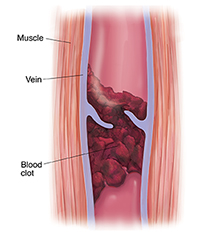Understanding Deep Vein Thrombosis (DVT) During Pregnancy and After Delivery
A deep vein thrombosis (DVT) is when a blood clot forms in a vein deep in your body. This often occurs in a leg vein. But it can also occur in an arm or the pelvis.
 |
| Deep vein thrombosis. |
DVT can be dangerous because the blood clot can break off and travel to the lungs. The clot can then stay in a blood vessel in the lungs and block blood flow (called a pulmonary embolism or PE). This blockage is a medical emergency and can be deadly.
Here’s what you need to know about diagnosing and treating DVT during pregnancy and after your delivery.
Blood clots and pregnancy
Women have a higher risk for DVT during pregnancy, delivery, and for about 6 to 8 weeks after giving birth. This is because pregnancy raises the pressure in the veins in your legs and pelvis. This risk is even higher for pregnant women with any of these risk factors:
-
A past blood clot or family history of blood clots
-
Being overweight
-
Pregnant with twins or more
-
Taking medicines that increase the risk of clotting, such as birth control pills or estrogen hormones
-
Not being active due to bed rest, resting after delivery, or long-distance travel
-
Diabetes
-
High blood pressure
-
Being age 35 or older
-
Having another illness during pregnancy, such as pre-eclampsia, cancer, or severe infection
-
Having a Cesarean delivery
Symptoms of DVT
The more common symptoms of DVT often occur in a leg and may include:
-
Leg pain or soreness, sometimes only when standing or walking
-
Affected part of the leg is red, swollen, and hot
If you have any of these symptoms, call your healthcare provider. It’s common to have some leg pain and swelling during pregnancy. So these symptoms may not mean that you have DVT. But check with your provider.
Diagnosing DVT
If your healthcare provider thinks you may have DVT, you may have tests to see if you have a blood clot:
-
Ultrasound. This test uses sound waves and a computer screen to show an image of your baby inside your uterus. It can also show blood flow in your veins and spot any blockages.
-
MRI. This makes a detailed image of the inside of your body.
Treatment for DVT
Medicines
Treatment for DVT mainly includes blood-thinning medicines (anticoagulants). These are medicines that help stop your blood from clotting. Safe medicines during pregnancy include certain forms of heparin. Your healthcare provider may also refer you to a specialist who treats blood conditions (hematologist).
After delivery, you will likely continue taking medicine for at least 6 weeks after delivery. If your DVT was found late in your pregnancy or after childbirth, you may need treatment for a longer time. You may keep using heparin. Talk with your healthcare provider about your treatment plan.
Surgery
A few different types of procedures may be used to treat DVT:
-
Placing a filter in the largest vein (the inferior vena cava) to stop blood clots
-
Injecting the vein or lung artery with medicines to break up the clot
-
In rare cases, a large clot may be removed from a vein
What you can do
Other things you can do to stay healthy when you have a DVT:
-
Wear special stockings (compression stockings) to reduce leg swelling
-
Stay active, as advised by your healthcare provider
Ask your healthcare provider what pain relievers you can take.
Call 911
Call 911 right away if you think you may have symptoms of a pulmonary embolism. Symptoms may include:
When to call your healthcare provider
Call your healthcare provider right away if you are pregnant or recently had a baby and you have these symptoms:
-
Leg pain or soreness, sometimes only when standing or walking
-
Affected part of the leg is red, swollen, and hot